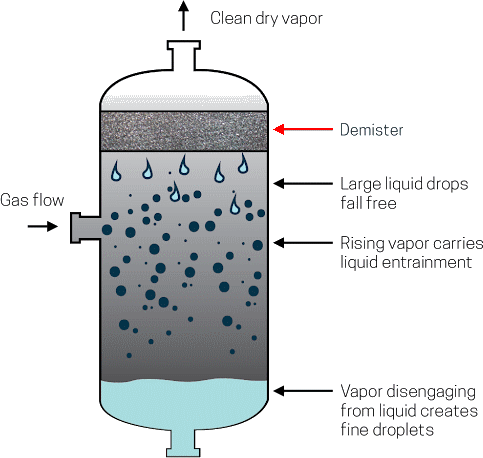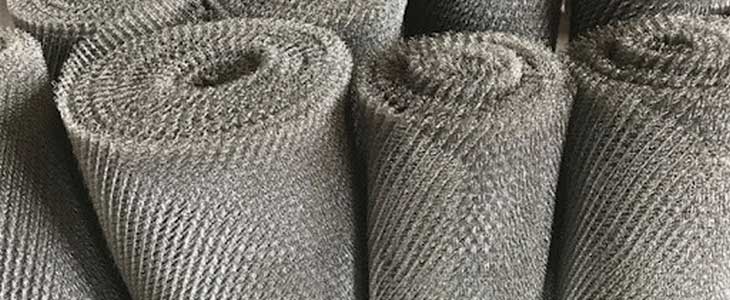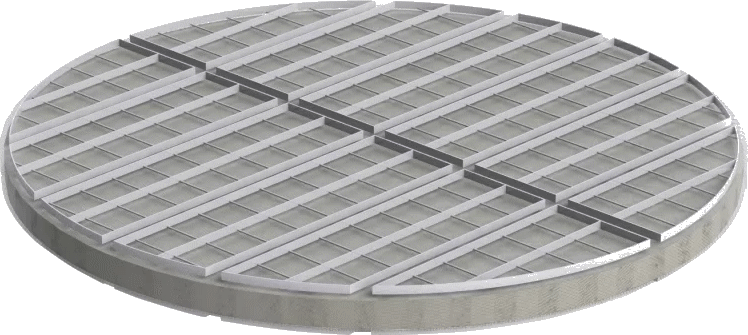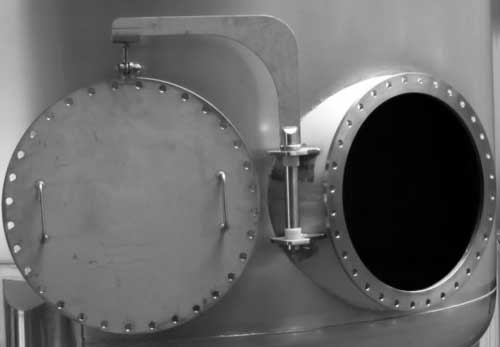 |
Demister Pad's in Process Piping |
DEMISTER PAD's are similar to air filter's, which are used for removing dust particles from a stream of air. The demister pads are used to removing micron-size liquid particles from a vapor stream.
Original demisters installed in a large demister tower can not blocks the mini liquid droplets into the downstream compressor. They will vaporized and leaving behind solid deposit on the impeller. Over time, the deposit may break off and impact the normal operation of critical unit. The demister pads can solve these problems due to its special structure and high filtering efficiency.
Demister pad, also called mist eliminator, vapor pad, is made of knitted wire mesh, which is woven interlocked and ensure the even and smooth meshes for filtering. The meshes can be customized to suit different filtering requirements. It is commonly used with structured packing and random packing to be used in the separating towers or distillation towers.
History of demister pad
The late fifties, the foreign used an apparatus which made of the special wrinkle woven mesh to remove inclusions of tiny liquid foam in the gas. Then it is found that is very efficient and the resistance is very small, which is unmatched by other gas-liquid separation device, so it is widely accepted and used in a wide range of applications.
Demister pad is commonly placed at the top of the packing tower, which can not only ensure the mass transfer efficiency, but also reduce the board spacing. Demister pad is widely used in chemical, petroleum, pharmaceutical, light industry, metallurgy and other industrial production in the vertical cylindrical equipment vapor-liquid separation device. It can also be used in the desulfurization and other productions to remove oil mist, toxic and poisonous gas.
Working principle of demister pad

When the gas with mist rises at a constant speed and passes through the wire mesh, the rising
mist will collided with the mesh filament and attached to the surface filament due to the inertia
effect. The mist will be diffuse on the filament surface and the droplet will follow along the filaments
of the two wire intersection. The droplet will grow bigger and isolate from the filament until the
droplets gravity exceeding gas rising force and liquid surface tension force while there is little
gas passing through the demister pad.
Separate the gas in the droplets can improve the operating condition, optimize process indicators,
reduce corrosion of the equipment, extend equipment life, increase the amount of processing and
recovery of valuable materials, protect the environment, and decrease air pollution.
What does a demister pad look like..
Demisters come in a variety of shapes and sizes and can be installed horizontally or vertically. A typical horizontal demister resembles a large steel wool mesh pad, several feet in diameter and, 6 to 12 inches thick.

Knitting Wire Mesh Corrosion Resistance For Demister Pad

Fine diameter wires which are typically ~0.011 inches in diameter are interlocked by a weaving operation to form a wire mesh pad with a high free volume (97% to 99+% void fraction) and of uniform density. A “tight” mesh (a lower void fraction and more dense) is more effective, i.e., it captures smaller diameter liquid droplets vs. an “open”, less dense mesh with a greater void fraction.
The principal determinant in the selection of the demister for the issue described herein was flooding. In a typical demister installation, a thin disengaging zone of bubbling liquid (1 or 2 inches in height) develops at the bottom edge of the demister pad. The remaining mesh (active zone above the liquid layer) captures the droplets. The liquid droplets coalesce on the wire mesh and then drain by gravity and accumulate in the disengaging zone, ultimately dripping to the liquid pool in the bottom of the vessel. As the velocity/liquid loading increases, the thin disengaging zone of liquid increases in height moving further into the active zone until carryover of liquid occurs, i.e., the demister is flooded, and liquid is carried over into downstream piping and equipment.
The flooding point of a demister is a function of many variables including demister design, vapor and liquid densities, vapor velocity, liquid loading, and liquid properties such as viscosity and surface tension. Although a simple looking device, a lot of know-how and testing dating back to the 1950’s is embodied in their design.
Maintenance of demister pads
After using for a long time, the demister pad will clog or prone to flooding and the pressure drop will increase. All these because of the particles in the gas blocks the demister pad. So you need maintain the demister pad properly and regularly.
Reference(s)(s).. demisterpads.com becht.com
Related Post(s)

A manhole is installed in storage tanks, pressure vessels, drums, columns and serves as a passage and vent for personnel during installation, repair, cleaning and maintenance...